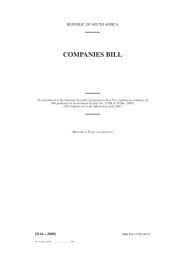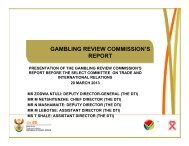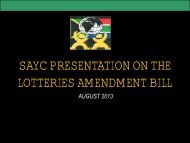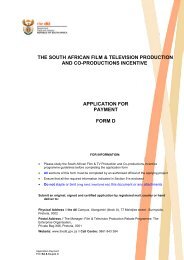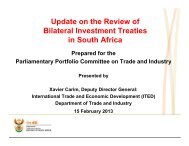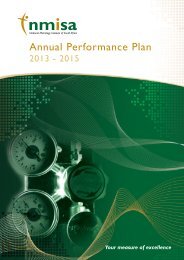Copyright Review Commission Report - ICT Law and Regulation ...
Copyright Review Commission Report - ICT Law and Regulation ...
Copyright Review Commission Report - ICT Law and Regulation ...
- No tags were found...
Create successful ePaper yourself
Turn your PDF publications into a flip-book with our unique Google optimized e-Paper software.
xiii.In Chapters 6 <strong>and</strong> 7, the CRC sets out the respects in which the collecting societies have failed to comply withthe applicable principles of sound corporate governance <strong>and</strong> Collecting Society <strong>Regulation</strong>s. The <strong>Commission</strong>recommends that adherence to the good principles of corporate governance (e.g. King III) be compulsory forcollecting societies, <strong>and</strong> that the Registrar be empowered to take over the administration of any such societyshould he or she be satisfied that it is being run in a manner that is detrimental to the respective rights holders.xiv.The CRC considered the circumstances surrounding the collapse <strong>and</strong> liquidation of one collectingsociety accredited under the regulations, <strong>and</strong> makes recommendations as to what action should be taken byliquidators <strong>and</strong> what should be done to avoid further collapses. See Chapter 7, paragraph 7.1 <strong>and</strong> paragraph7.4.1.xv.The costs-to-royalty income ratio (i.e. administration costs as a percentage of total collections) for collectingsocieties selected for international benchmarking purposes varies between 10% <strong>and</strong> 24%. (The maximumallowable ratio is 20% in terms of current local regulations, which the CRC regards as appropriate.) The CRCbelieves that SAMRO’s current ratio of approximately 30% is excessive in relation to the international average.This is confirmed by the fact that when compared with other collecting societies, SAMRO has the lowestaverage ratio of revenue collected to labour costs. The CRC recommends that SAMRO be given three years toresolve this matter. See Chapter 10, paragraph 10.12.1.xvi.The CRC analysed the amounts of money collected <strong>and</strong> thereafter distributed, as well as the efficacy ofattempts to trace persons in cases where royalties could not be distributed because the persons entitled theretocould not be identified. Recommendations are made as to what should be done to identify <strong>and</strong> trace thepersons concerned. See Chapter 10, paragraph 10.12.7.xvii.The CRC ascertained that approximately 24% (as per Table 17 in Chapter 10) of royalties collected are paid tolocal authors <strong>and</strong> composers. This is due to the fact that local music content usage is significantly lower thanthat of non-local content. The CRC recommends that the local music content targets gazetted by theIndependent Communications Authority of South Africa (ICASA) be raised significantly <strong>and</strong> that the monitoringprocess be strengthened. See Chapter 11, Table 26 (a), (b), (c), (d) <strong>and</strong> (f) <strong>and</strong> Chapter 10, Table 17 (j).xviii.The CRC compared tariffs charged in South Africa with those in Brazil, France, India, Norway, Senegal,Switzerl<strong>and</strong> <strong>and</strong> the United Kingdom (UK), <strong>and</strong> found that most of the tariffs applied in South Africa weresignificantly lower. See Chapter 8, paragraph 8.2.12.xix.The CRC analysed examples of contracts between collecting societies <strong>and</strong> users <strong>and</strong> between performers <strong>and</strong>recording companies <strong>and</strong> made recommendations as to what improvements should be effected. the dti is urgedto draw up st<strong>and</strong>ard contracts between performers <strong>and</strong> record companies that are fair to both sides <strong>and</strong> thatparties to such agreements are encouraged to use. See Chapter 10, paragraph 10.12.5.xx.The CRC believes that the <strong>Copyright</strong> Act must be amended to provide for the reversion of assigned rights toroyalties 25 years after the assignment of such rights. Such an amendment will help relieve the plight ofcomposers whose works still earn large sums of money, which are going to the assignees of the composers’rights long after the assignees (or their predecessors) have recouped their initial investment <strong>and</strong> madesubstantial profits, in excess of those anticipated when the original assignment was taken. See Chapter 10,paragraph 10.12.10.- 5 -





